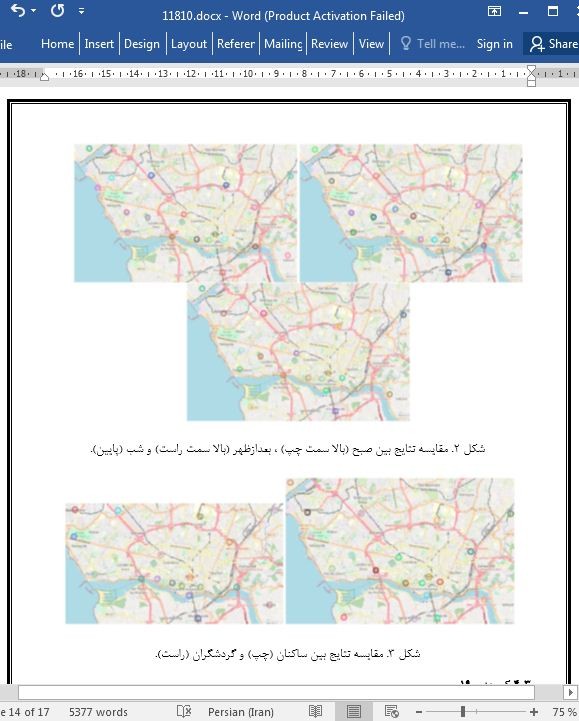
درک الگوهای تحرک و فعالیت های کاربر از داده های شبکه های اجتماعی
چکیده
شبکه های اجتماعی در زندگی روزمره جامعه مدرن حضور پرقدرتی دارند. اغلب افراد از این شبکه های اجتماعی به منظور به اشتراک گذاشتن اطلاعاتی در مورد زندگی شخصی خود، نظرات خود، مکان هایی که بازدید می کنند و وضعیت روحی خود استفاده می کنند. به صورت کلی، این پست ها از اطلاعات مختلفی تشکیل شده اند، زیرا موقعیت مکانی کاربران بخشی از داده ها است. هدف از این تحقیق جمع آوری موقعیت پست ها و مشاهده الگوی تحرک کاربران در شهر پورتو، پرتغال است. در این مقاله فن آوری های موجود مربوط به جمع آوری داده ها، شبکه های اجتماعی که در حال حاضر ارزش مطالعه دارند و محدودیت های مربوط به آنها مورد بحث قرار می گیرد. همچنین با رعایت تمام محدودیت هایی که در حال حاضر اعمال می شود، رویکردهای جدیدی را مربوط به جمع آوری داده ها از شبکه های اجتماعی مورد نظر بررسی می کند. راه حل های مختلف نرم افزاری ایجاد شده مربوط به تعاملات شبکه های اجتماعی به طور عمیق بررسی و توصیف شده است. پس از آن، نرم افزار لازم مربوط به شبکه های اجتماعی بررسی می شود، الگوریتم های احتمالی داده کاوی مورد بحث قرار می گیرد و اجرای آن ارائه می شود. سرانجام، نتایج بدست آمده مطابق با ویژگی های شهر، ترویج گردشگری و مسیرهای حمل و نقل تفسیر و مطالعه می شود.
1. متن اصلی
با رشد جمعیت در سراسر جهان به صورت تصاعدی، اغلب متدولوژی های برنامه ریزی شهری نیز مجبور به تکامل فن آوری های پیشرفته و اطمینان از منسوخ نشدن فرایندها شده اند. برنامه ریزی شهری موضوعی است که مسئول طراحی، ساخت و توسعه منابع زمین ، هوا و آب مربوط به خدمات بهتر به مردم است. همچنین مسئول مواردی مانند زیرساخت ها ، ارتباطات ، توزیع و حمل و نقل عمومی است. در مطالعه ای مک گیل تحرک مردم اطلاعاتی را در مورد زیرساخت ها و مسیرهای حمل و نقل عمومی، توزیع پلیس و توسعه راه ها بیان می کند. تا این اواخر، این مطالعات پر هزینه و طولانی بودند. با این حال ، امروزه افراد تمایل دارند اطلاعات شخصی خود را از طریق برنامه های تلفن های هوشمند به اشتراک بگذارند.
5. نتیجه گیری و پژوهش های آینده
ابتدا، این پژوهش ثابت کرد که استفاده از شبکه های اجتماعی مبتنی بر مکان مربوط به جمع آوری داده در حالی که به دلیل GDPR تحت محدودیت های زیادی قرار دارد ، امکان پذیر است. سپس ، داده های جمع آوری شده اطلاعات و جزئیات کافی را به منظور نتیجه گیری معنی دار در مورد الگوهای تحرک کاربران فراهم آورد.
Abstract
Social networks are strongly present in the daily life of modern society. Most people use these social networks to share information about their lives, their opinions, places they visit and their state of mind. Generally, these posts are composed of various information, being the location of the users location part of the data. The purpose of this work is to obtain the location of the posts and observe the users mobility pattern in the city of Porto, Portugal. This paper discusses the technologies available for obtaining the data, the social networks currently worth studying and their respective restrictions. It also explores new approaches to collect the data from the desired social networks, respecting all restrictions currently applied. The different software solutions developed for the social networks interactions are explored and described in depth. Subsequently, the necessary software for social networks is reviewed, the possible algorithms for data mining are discussed and its implementation is presented. Finally, the results obtained are interpreted and studied according to the characteristics of the city, tourism promotions and transport routes.
1. Main Text
As the population grows exponentially around the world, most urban planning methodologies have also had to evolve to integrate the latest technologies and ensure that processes do not become obsolete. Urban planning is the subject responsible for designing, building and developing the land, air and water resources to better serve the population. It is also responsible for subjects like infrastructure, communications, distribution and public transportation. McGill The study of people’s mobility provides information on public transport infrastructure and routes, police distribution and road development. Not so long ago, these studies were expensive and long. However, nowadays people are willing to share personal information through smartphone apps.
5. Conclusions And Future Work
First of all, this research proved to be possible to still use location based social networks for collecting data while being subject to many restrictions due to GDPR. Then, the data collected provided enough information and details for drawing meaningful conclusions about users mobility patterns.
چکیده
1. متن اصلی
2. حالت پیشرفته
3. روش شناسی
3.1. روش های جمع آوری داده ها
3.2. منابع اطلاعات
3.3. فرآیند دستکاری داده ها
3.4. داده کاوی
4. بحث و نتیجه گیری
4.1 نتایج بدست آمده
4.2 تجزیه و تحلیل مکانی – زمانی
4.3 کووید -19
4.4 تمام نقشه ها
5. نتیجه گیری و پژوهش های آینده
منابع
Abstract
1. Main Text
2. State Of The Art
3. Methodology
3.1. Data Collection Methods
3.2. Data Sources
3.3. Data Manipulation Process
3.4. Data Mining
4. Results And Discussion
4.1. Results Obtained
4.2. Spatio-Temporal Analysis
4.3. COVID-19
4.4. All The Maps Created
5. Conclusions And Future Work
References
- اصل مقاله انگلیسی با فرمت ورد (word) با قابلیت ویرایش
- ترجمه فارسی مقاله با فرمت ورد (word) با قابلیت ویرایش، بدون آرم سایت ای ترجمه
- ترجمه فارسی مقاله با فرمت pdf، بدون آرم سایت ای ترجمه



